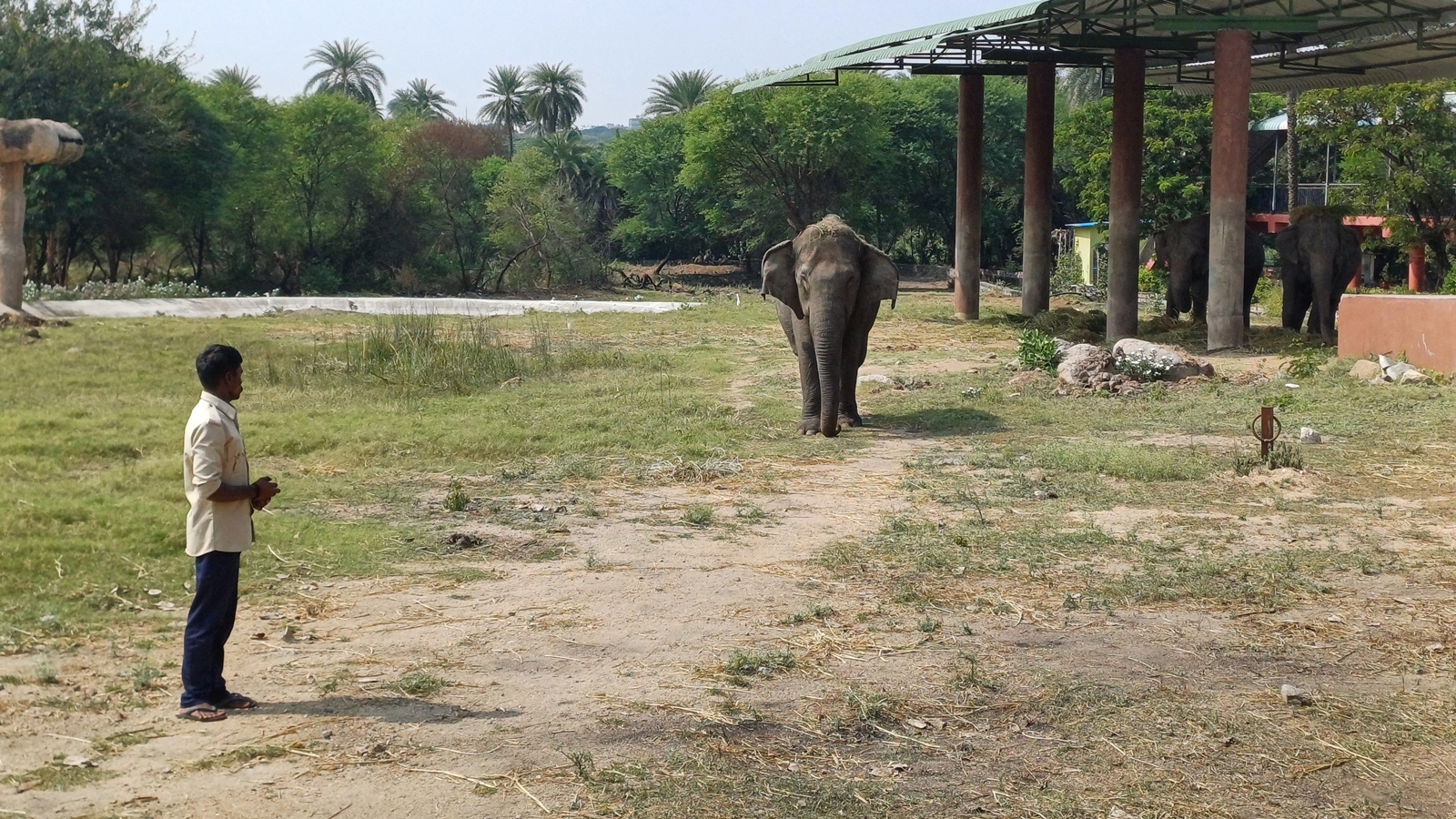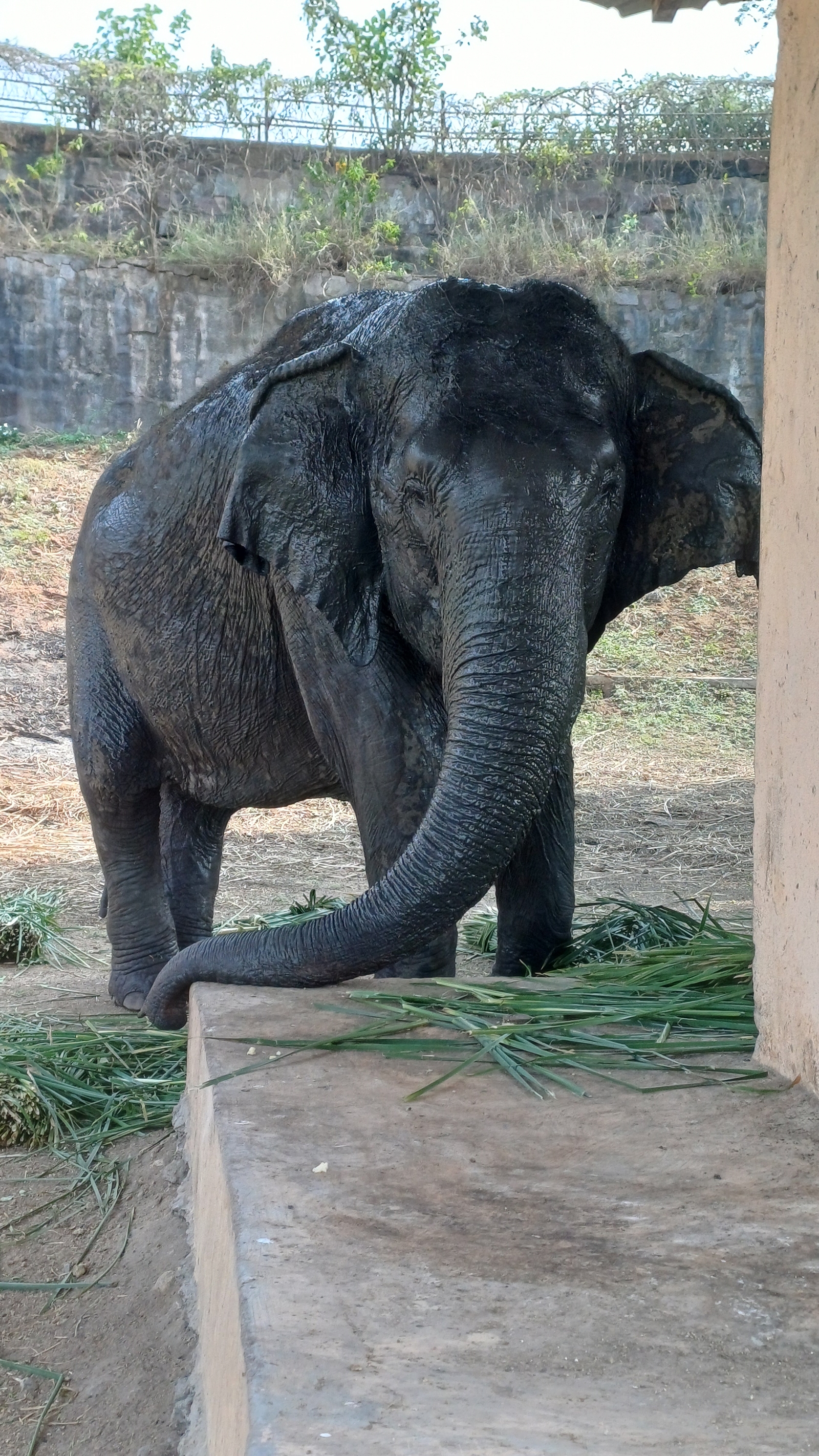As Wasim called out their names, Vanaja slowly ceased her activities and walked towards him, while Asha and Sita remained indifferent. Wasim notes that the two have grown closer, exhibiting more natural behaviours. A little away from them and the visitors, Vijay continues his solitary activities. The past few months have brought about a radical change in their lives.
The elephants Vanaja, Asha, Sita, and Vijay are part of an innovative experiment designed to provide them with a more stimulating and natural environment, akin to that of wild elephants. Wasim, one of the mahouts at Nehru Zoo Park in Hyderabadpoints out that the elephants are thriving in their new surroundings.
The incident that sparked the change began last October with the tragic death of 23-year-old animal keeper Md Shaibaz. He was fatally injured by Vijay, who was in a state of “musth”, a periodic condition in bull elephants characterised by aggressive behaviour and accompanied by a significant rise in reproductive hormones. This fatal accident involving an elephant was the first ever at the zoo and forced officials to reevaluate its elephant care protocols.
“The zoo is now focusing on understanding elephant behaviour and reducing stress factors to prevent future tragedies and improve their overall well-being,” Deputy Conservator of Forests and zoo curator Sunil S Hiremath, the man helming the change, tells indianexpress.com. He believes that the elephant cannot be made a villain in the case of any tragedy and asserts that the new methods implemented in the last two months have yielded positive results. The zoo also plans to document its research and practices to establish a standardised approach for zoos across the country.
The Nehru Zoo Park recently turned 61 and is one of the oldest zoos in the country. It spans 380 acres and houses four elephants among 2,400 mammals, reptiles, birds, and other species. Hiremath proudly says that the zoo was the first to introduce several innovative concepts, such as a nocturnal house, an open butterfly park, and a safari on the zoo’s premises.
Vanaja (Rajini), 54, previously served during religious processions. The Nizam Trust handed her over to the zoo in 1990. Asha, 52, was acquired from a Chennai elephant farm, while Sita, 38, was rescued from a circus and transferred to the zoo by a court order. Vijay, now 38, was rescued as a calf from the Tirupati forests in 1996 and has remained at the zoo ever since.
 The zoo is periodically monitoring the elephants’ stress levels by analysing hormone levels in their dung samples. (Express photo by Rahul V Pisharody)
The zoo is periodically monitoring the elephants’ stress levels by analysing hormone levels in their dung samples. (Express photo by Rahul V Pisharody)
To better understand elephants in captivity, the zoo officials enlisted the services of Steve Koyle of Elephant Care Unchained in the United States and Bengaluru-based elephant conservationist G R Govind. According to the zoo officials, their interventions resulted in the mahouts adopting a more humane approach, abandoning the use of traditional tools like the ankusha (a bullhook or elephant goad). Expert mahouts, such as Wasim, were hired as a first step to assist the animal keepers.
Story continues below this ad
Hiremath says that the elephants were previously always tied and shifted to night shelters in the evening, forced to stand on the concrete flooring of the stall structure. They have since discarded the chains and are now free to roam around a 10-acre campsite without being moved to night shelters.
 “It was important to change the mindset of our keepers,” Deputy Conservator of Forests and zoo curator Sunil S Hiremath said. (Express photo by Rahul V Pisharody)
“It was important to change the mindset of our keepers,” Deputy Conservator of Forests and zoo curator Sunil S Hiremath said. (Express photo by Rahul V Pisharody)
Keepers have stopped harsh treatments, including the use of the ankush. “Elephants need a soft surface to walk on, and they are used to walking hundreds of kilometres every day. Not only do we leave them free, but we have introduced various activities for them. We do not leave the feed at the same place every time. They have a swimming pool, mud bath, dust bath, and water shower, all designed to provide them with a more stimulating and natural environment,” he says.
The zoo is periodically monitoring the elephants’ stress levels by analysing hormone levels in their dung samples. According to Hiremath, animals, including elephants, are prone to stereotypic behaviour that indicates their stress levels, and hence they are given feed at multiple locations and allowed to engage in activities on their own.
“When the routine scenario changed two months ago, the elephants were not sleeping for two days. They were expecting to go back to the shelter. Now they are used to sleeping in the park. They have their hiding places to sleep,” Hiremath adds.
Story continues below this ad
Wasim points out that the feed includes fruits and vegetables, ghee, and ragi, apart from bales of green grass. “Now Asha and Sita are close friends. They do everything together. Vanaja is on her own. Asha and Vijay have grown closer, but the other two female elephants are scared of Vijay. They have an environment similar to a forest, and each night they choose their spots to sleep. All of them are very friendly,” he adds.
 Further collaborations are being explored with the Indian Veterinary Research Institute, P V Narsimha Rao Telangana Veterinary University, and Professor Jayashankar Telangana State Agriculture University. (Express photo by Rahul V Pisharody)
Further collaborations are being explored with the Indian Veterinary Research Institute, P V Narsimha Rao Telangana Veterinary University, and Professor Jayashankar Telangana State Agriculture University. (Express photo by Rahul V Pisharody)
Due to a lack of sufficient walking, non-trimming of toenails, and standing for long hours on concrete, the elephants developed abscesses in their feet. Dr M A Hakeem, Deputy Director (veterinary), explains that the two elephant experts shed much light on elephant foot care.
“Their toenails are trimmed, limbs massaged, toes are washed and dipped in warm water, etc. Elephants carry a total weight of about 4,500 kg on their four limbs, and blood supply in the feet is very important,” Hakeem says. “Earlier, we did not do it scientifically. Our people are now trained to access their feet without disturbing the animal and how to divert their focus with different touches on its body.”
In the past, the elephants were taken for an hour-long walk every morning and left in the camp until 4.30 pm, after which they were shifted to the night shelter. Now, they are living freely without chains or dedicated shelter. Zoo biologist Dr B Laxmi Narayana points out that this has led to the elephants developing their instincts to up to 60 to 70 per cent. “In a way, now they are on their own. They decide what to do and when. They choose where to sleep. The rocks, shrubs, trees, and grasslands at the camp take them closer to their habitat,” he says.
Story continues below this ad
“It was important to change the mindset of our keepers. They think an elephant will listen only if you poke it with a bullhook at certain points. That’s old school. Due to support from the two elephant experts, we now have a touch-and-treat (reward) method which involves no harsh treatment,” Hiremath adds.
The zoo has initiated a partnership with the Centre for Cellular and Molecular Biology and its Laboratory for the Conservation of Endangered Species—CCMB-LaCONES—to research stem cells and elephant stress levels. Additionally, the zoo is in discussions with AIIMS-Bibinagar to collaborate on zoonotic disease research. Further collaborations are being explored with the Indian Veterinary Research Institute, P V Narsimha Rao Telangana Veterinary University, and Professor Jayashankar Telangana State Agriculture University.
‘Elephants are not objects of entertainment’
“Just imagine, the bull elephant (Vijay) has been standing chained in a concrete box for the past 14 months, in his piss and dung, at one place just waiting for food and doing nothing else,” says Govind. Similar was the life of the three female elephants—standing for at least 16 hours in a concrete stall with hard flooring, though they were occasionally let free near their display area. “Barring in four or five sanctuaries, humane treatment towards elephants is a rarity across the world. I can vouch and say no zoo across the world has such facilities and care for captive elephants as the Hyderabad zoo has adopted. Now, the elephant display area in Hyderabad Zoo is the biggest (around 10 acres) in the world,” he states.
According to him, just tying the bull elephant under a tree as a first step brought about a big change. So was the change in the three female elephants. Vijay currently is in musth and hence is left in a separate enclosure. He is tied to a tamarind tree with a 30-ft-long chain on one leg. Despite being in musth, and unlike in the past 14 months, he now has the freedom to move around the mud floor, scratch on a tree, and even break and eat its branches and bark, just like in its natural habitat.
Story continues below this ad
“An elephant in musth is not a vicious killer. If you treat him well, he will understand well. We have to equate them to us. They are not objects of entertainment. Within the limitations, what best can we do? That is our concept,” the conservationist adds.
Recently, Vijay’s chain was entangled and without much drama, it was untangled by the staff while one of the keepers left him some food at a distance. This, according to Govind, is a success, especially considering Vijay’s musth state. Govind notes that the zoo is going to build a separate enclosure on two acres within the 10-acre elephant camp for Vijay. The designs to make it an enjoyable interaction have been shared with the zoo so that Vijay can interact with the females while he stays separate from them.”






